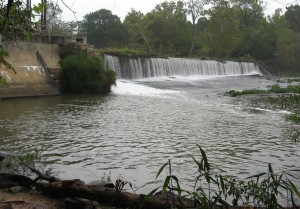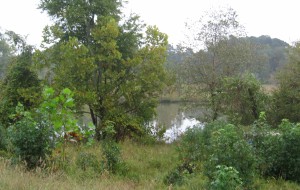
Buckeye Trail, which tracks Crabtree Creek through the largest natural area inside the beltline, runs 3 miles from due east of Raleigh at Milburnie and New Bern to Raleigh Boulevard in Northeast Raleigh. There it meets Raleigh Swamp, the neighborly name for the large shallow body of open water bisected by Raleigh Boulevard just north of Crabtree Boulevard.

But this section will be slightly iffy for the next 12 months as crews work on renovating the sewer lines that also track the creek, usually right next to the greenway. I was startled to see the sign, then realized the closings were going to be based on immediate project need, and that people were utilizing the trail as usual that very morning. I thoughtfully and slowly biked the entire length, stopping to check on some late summer blooms and the condition of the Rocky Overhang, my sentimental favorite spot from childhood jaunts to Crabtree from Gatewood, my east Raleigh neighborhood. Raleigh Nature has looked several times at this oldest leg of the Raleigh greenway, but a brief catalog of its wonders seems in order.
First, the old landfill meadow at the Milburnie entrance is apparently not going to get mowed anymore – there are trees of several years age filling up the back third. The rest is filled with microstegium, stilt grass or bamboo grass: by any name, as nefarious an invasive species as kudzu ever was. Perhaps the landfill monitoring period is over, perhaps they will bushwack these trees eventually. Minus the stiltgrass, it was a rich meadow. Two pairs of comparison pictures below (click to enlarge).




Just past this meadow is a large stand of young beeches standing in a floodplain. As you leave them and approach Crabtree, the sewer line cuts under the greenway on its way to Milburnie Road. This is where the work is starting. Necessary work, plus they are protecting the terrain by mulching with what they grind – at least for now. I actually like the new openings and hiking possibilities created by these cuts. Until the poison ivy gets established.

Sewer work at eastern end of Buckeye Trail

I can understand the need for the work. Above is a section of sewer line inundated by winter floods, seen from the elevated greenway by the pump station at the dead end of Crabtree Boulevard. This flooding is natural and used to happen with more regularity before the construction of flood controls upstream.

My first nature stop on the bike found me stumped. I knew I had encountered the triangular, papery fruits and their name, but couldn’t put the two together. A field guide finally revealed it as American Bladdernut. Right beside it, pictured below, was a plant I did remember – nettle, whose thin hairy needles inject a stinging but mild toxin that can serve as relief from arthritis, a fact I learned from long-time NC Wildlife photographer Ted Dossett, who used to walk Buckeye almost daily.

Further upstream, the creek takes a big turn, away from Yonkers and toward Milburnie, creating The Point, a triangular beach looking across at the eastern edge of the Marsh Creek marsh. This broad wetland stretches for about a mile below Yonkers Road and the Beltline. This is a great spot to see the larger birds. Buckeye is “the birdiest greenway trail” according to the Wake birders’ guide. As I headed upstream toward Rollingwood, I stopped at a very special place where a big beech uses a rock formation to hang right over the water. Its roots create undercaves that we used for caching supplies back in grade school – toilet paper, BBs, and matches. If we left anything long, it would wash away in high water. The spot beside the beech is pictured below in very low water.

Crabtree on east Buckeye Trail
I continued my ride, briefly surveying the Rocky Overhang, still draped by a large fallen Sycamore that came down across the creek after Floyd in 1999. Fallen trees are a big part of changes in the creek bed, and the sycamores are notorious for taking up doomed positions on the creek bank. Sometimes they lean precariously for years, and I will never forget the Buckeye walk when a really large, vine encrusted hickory decided to slowly but powerfully lay itself down into the creek as I walked past. It was an amazing sound – non-violent but death-dealing forces of gravity and release.

Glimpse of the rocky overhang on Buckeye
Halfway up the trail is the park at the bottom of Rollingwood, where the greenway leaves the creekside and edges the neighborhood. The creek formerly split, creating an “island” which edged the greenway, but that streambed is dry now. Shrubs and young trees cover the large sandy beach that existed at the head of this island in my childhood. Unforgettable memories of camping on that beach (even then the water flow was seasonable), drawing a large square in the sand, and boxing with gloves! It was my first and only experience with that. The stalwart group of boys with whom I had ingratiated myself screamed and exhorted like we were Lords of the Flies. We walked the creekside ( no greenway on those days) all the way up to Downtown (Capital) Boulevard to go get milkshakes late that night. Fun times.

Now the creek goes straight past the former island, and the sand piles up just short of the former split. Above is Sandy Beach, a favorite spot of my own children (though I never allowed them to camp there). From here up to Raleigh Boulevard is a straight stretch that is close but not connected to my old gatewood neighborhood at the ends of King Charles and Marlborough. Those streets took major damage from our April tornado disaster, and the damage shows from and includes the greenway.


This stretch is now VERY sunny and the flowers will make use of that. A selection is below. Be sure to visit Buckeye soon!

Jerusalem Artichoke, which has an edible root










































